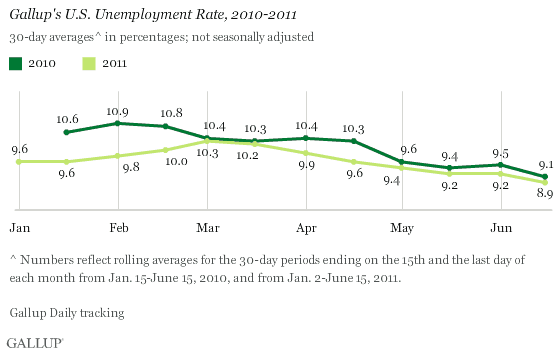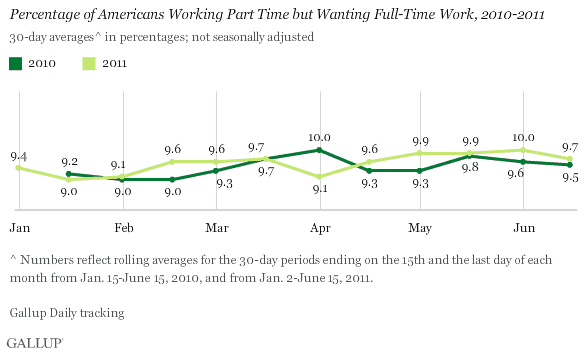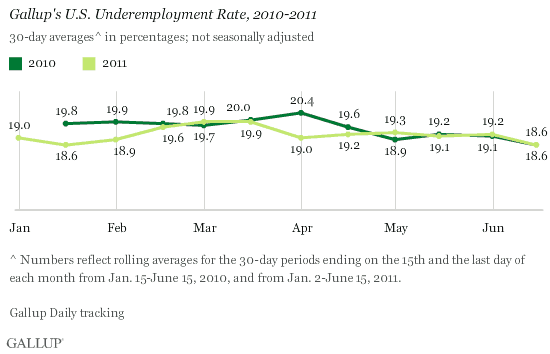PRINCETON, NJ -- Unemployment, as measured by Gallup without seasonal adjustment, is at 8.9% in mid-June -- down from 9.2% at the end of May and 9.1% in mid-June a year ago.

The percentage of part-time workers who want full-time work is at 9.7% in mid-June -- an improvement from 10.0% at the end of May. However, slightly more Americans are now working part time but seeking full-time work than was the case a year ago.

Underemployment Down Slightly, but Still High in Mid-June
Underemployment, a measure that combines the percentage of unemployed with the percentage working part time but wanting full-time work, was at 18.6% in mid-June -- down from 19.2% at the end of May. However, underemployment is just as high now as it was in mid-June 2010.

Implications
Gallup's U.S. unemployment and underemployment data indicate a modest improvement in job market conditions in mid-June compared with the end of May. This may partly result from a seasonal increase in employer hiring; Gallup's data do not adjust for such changes. Still, underemployment remains at 2010 levels.
However, unemployment and underemployment tend to lag economic activity. Gallup's employment data from the second quarter of the year are consistent with the modest 1.8% U.S. GDP growth in the first quarter of 2011. But Gallup's measures did not show the improvement suggested by the government's unemployment numbers earlier this year or the deterioration during April and May. Instead, they have shown the 2011 unemployment situation to be similar to that of 2010.
In turn, this suggests the real jobs situation right now may be slightly better than the May government unemployment report implies and similar to that of a year ago. On the other hand, the continued stagnation or further deterioration in the U.S. economy that seems to be happening during the second quarter of 2011 may not be fully reflected in Gallup's mid-June numbers.
Gallup.com reports results from these indexes in daily, weekly, and monthly averages and in Gallup.com stories. Complete trend data are always available to view and export in the following charts:
Daily: Employment, Economic Confidence and Job Creation, Consumer Spending
Weekly: Employment, Economic Confidence, Job Creation, Consumer Spending
Read more about Gallup's economic measures.
View our economic release schedule.
Survey Methods
Gallup classifies American workers as underemployed if they are either unemployed or working part time but wanting full-time work. The findings reflect more than 18,000 phone interviews with U.S. adults aged 18 and older in the workforce, collected over a 30-day period. Gallup's results are not seasonally adjusted and are ahead of government reports by approximately two weeks.
Results are based on telephone interviews conducted as part of Gallup Daily tracking from May 16-June 15, 2011, with a random sample of 18,636 adults, aged 18 and older, living in all 50 U.S. states and the District of Columbia, selected using random-digit-dial sampling.
For results based on the total sample of national adults, one can say with 95% confidence that the maximum margin of sampling error is ±1 percentage point.
Interviews are conducted with respondents on landline telephones and cellular phones, with interviews conducted in Spanish for respondents who are primarily Spanish-speaking. Each sample includes a minimum quota of 400 cell phone respondents and 600 landline respondents per 1,000 national adults, with additional minimum quotas among landline respondents for gender within region. Landline telephone numbers are chosen at random among listed telephone numbers. Cell phone numbers are selected using random-digit-dial methods. Landline respondents are chosen at random within each household on the basis of which member had the most recent birthday.
Samples are weighted by gender, age, race, Hispanic ethnicity, education, region, adults in the household, and phone status (cell phone only/landline only/both, cell phone mostly, and having an unlisted landline number). Demographic weighting targets are based on the March 2010 Current Population Survey figures for the aged 18 and older non-institutionalized population living in U.S. telephone households. All reported margins of sampling error include the computed design effects for weighting and sample design.
In addition to sampling error, question wording and practical difficulties in conducting surveys can introduce error or bias into the findings of public opinion polls.
For more details on Gallup's polling methodology, visit www.gallup.com.
